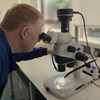From Lens to Lab: The Power of Photography in Tree Disease Identification

Forest Research
The photographs uploaded as part of a TreeAlert report are very important for the Forest Research Advisory team to make their first assessment of the issues affecting the tree of interest. This blog describes our tree disease diagnostic process as we examine each uploaded image for a range of information that can help us to identify the disease of concern.
We are unable to ask a tree how it is feeling. The first step in diagnosing tree diseases accurately is therefore relying on visual cues, whether these are by physically inspecting the tree, or analysing submitted photographs. When it comes to plant health, physical samples are best, however, it is not practical to send physical samples with every report of a diseased tree. A digital “sample” can be a good first step, and for a tree disease diagnostician, clear and detailed photographs are essential for the preliminary triaging of the tree’s issues.
Here are some guidelines for providing images that would help us to make meaningful assessments –
Take photographs of the tree from various angles to ensure that all aspects of the tree and what’s affecting it are well documented. When uploading photographs of potential plant disease problems to us, please also add additional information in the comments section. Photographs alone can provide valuable information, but the combination of photographs and other information, such as recent weather events (e.g. abnormal temperatures, heavy rainfall, ground compaction, etc) are all helpful.
We recommend that you take several photographs in the field, and upload only the best one in each of the three image categories we require (see below). It is also helpful for us to know that there are other images of the tree, besides the ones uploaded to TreeAlert, so that we can request more photographs if needed. We ask for images of the tree in the context of its surroundings, the symptom in context of its distribution on the tree and the symptom in detail. Combined, these provide us with a good understanding of the issues affecting the tree of interest. Unfortunately, we do occasionally get photographs that are less helpful to us. For example, images of silhouetted, blurred or obscured trees do not provide any useful information and make it very difficult for us to identify the issue or perhaps understand what is being reported. If in doubt about the quality of an image, ask yourself if you believe that someone else could clearly understand what you are showing them?
Image categories –
1. Tree in Context
The first image needs to be of the entire tree to give context and show the overall tree condition and structure. Take pictures from a distance to give us the ‘big picture view’. These should include the whole tree along with neighbouring plants and site conditions such as ground works, soil compaction, the tree being next to a road, etc. For example, for trees that may have Phytophthora ramorum, we are keen to see if there are any symptomatic Rhododendron shrubs next to the tree of interest. Another thing we look for in the Tree in Context images are the leaves and stem bark. Whilst most TreeAlert reports have the species of tree correctly identified, we do occasionally receive some where the tree is misidentified, or identification is necessary from the photographs. Tree in Context photographs could include, for example, crown decline, branch dieback, multiple bleeds on the stem, animal damage, foliage discolouration, etc. Images showing the distribution of symptoms on the tree help diagnosticians understand how the disease or pest spreads.
2. Symptom in Context
High-quality photographs provide detailed visual evidence of symptoms such as leaf spots, cankers, lesions, and leaf discolouration. This detail is crucial for identifying the specific characteristics of a disease. Where possible and safe to do so, zoom in on the specific parts of the tree showing the symptoms of interest. These could be, for example, one bleed area on the stem, several leaves showing leaf blotches, a patch of sooty bark disease, a bracket fungus, etc. Symptom in Context photographs can provide information on potential animal damage, such as squirrel damage above branches, deer damage to lower stem bark, badger claw marks, etc.
3. Symptom in Detail
Where possible, please try to take a close-up shot of the disease symptom or pest. If there are signs of the actual pests or parts of the pathogen (for example, honey fungus fungal mycelium or other fungal fruiting body structures) present on the plant part, try to zoom in and focus on these. Close-up shots of symptoms like leaf discoloration, leaf spots, stem cankers, or fruiting bodies are helpful if the images are in sharp focus to capture the fine details. What is useful is having a ruler, or a common object, positioned next to the diseased area as a reference to provide a sense of scale, especially for small symptoms. Objects like a coin, ruler, pen, etc, are helpful for this. With Symptoms in Detail images, it is especially important to take multiple photos to ensure that you will have at least a few good quality ones that are in focus.
Having examined photographs submitted through TreeAlert, we would either let the individual who submitted the report know what pests or diseases we suspect or request specific types of samples for further analytical or laboratory testing. Where it’s possible to obtain permission from the tree owner to collect such samples, it will make any follow-up investigation easier.
